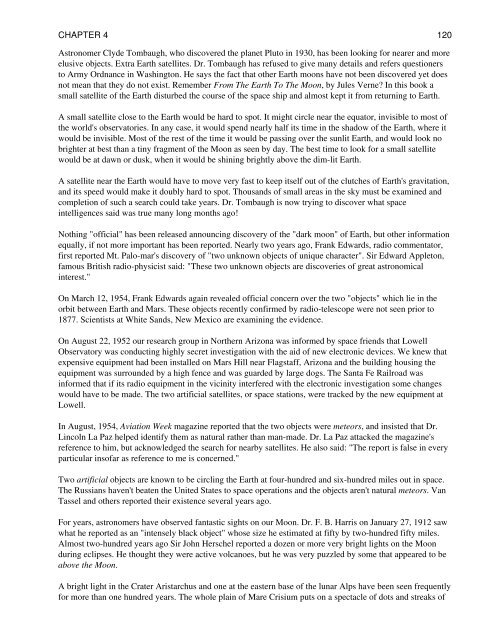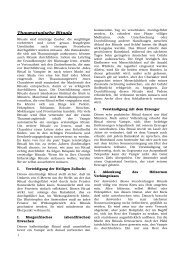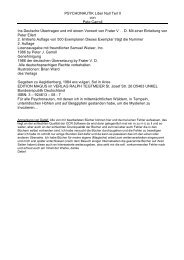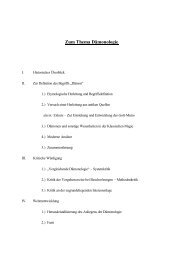CHAPTER 2 CHAPTER 3 CHAPTER 1 CHAPTER 2 CHAPTER 3 ...
CHAPTER 2 CHAPTER 3 CHAPTER 1 CHAPTER 2 CHAPTER 3 ...
CHAPTER 2 CHAPTER 3 CHAPTER 1 CHAPTER 2 CHAPTER 3 ...
You also want an ePaper? Increase the reach of your titles
YUMPU automatically turns print PDFs into web optimized ePapers that Google loves.
<strong>CHAPTER</strong> 4 120<br />
Astronomer Clyde Tombaugh, who discovered the planet Pluto in 1930, has been looking for nearer and more<br />
elusive objects. Extra Earth satellites. Dr. Tombaugh has refused to give many details and refers questioners<br />
to Army Ordnance in Washington. He says the fact that other Earth moons have not been discovered yet does<br />
not mean that they do not exist. Remember From The Earth To The Moon, by Jules Verne? In this book a<br />
small satellite of the Earth disturbed the course of the space ship and almost kept it from returning to Earth.<br />
A small satellite close to the Earth would be hard to spot. It might circle near the equator, invisible to most of<br />
the world's observatories. In any case, it would spend nearly half its time in the shadow of the Earth, where it<br />
would be invisible. Most of the rest of the time it would be passing over the sunlit Earth, and would look no<br />
brighter at best than a tiny fragment of the Moon as seen by day. The best time to look for a small satellite<br />
would be at dawn or dusk, when it would be shining brightly above the dim-lit Earth.<br />
A satellite near the Earth would have to move very fast to keep itself out of the clutches of Earth's gravitation,<br />
and its speed would make it doubly hard to spot. Thousands of small areas in the sky must be examined and<br />
completion of such a search could take years. Dr. Tombaugh is now trying to discover what space<br />
intelligences said was true many long months ago!<br />
Nothing "official" has been released announcing discovery of the "dark moon" of Earth, but other information<br />
equally, if not more important has been reported. Nearly two years ago, Frank Edwards, radio commentator,<br />
first reported Mt. Palo-mar's discovery of "two unknown objects of unique character". Sir Edward Appleton,<br />
famous British radio-physicist said: "These two unknown objects are discoveries of great astronomical<br />
interest."<br />
On March 12, 1954, Frank Edwards again revealed official concern over the two "objects" which lie in the<br />
orbit between Earth and Mars. These objects recently confirmed by radio-telescope were not seen prior to<br />
1877. Scientists at White Sands, New Mexico are examining the evidence.<br />
On August 22, 1952 our research group in Northern Arizona was informed by space friends that Lowell<br />
Observatory was conducting highly secret investigation with the aid of new electronic devices. We knew that<br />
expensive equipment had been installed on Mars Hill near Flagstaff, Arizona and the building housing the<br />
equipment was surrounded by a high fence and was guarded by large dogs. The Santa Fe Railroad was<br />
informed that if its radio equipment in the vicinity interfered with the electronic investigation some changes<br />
would have to be made. The two artificial satellites, or space stations, were tracked by the new equipment at<br />
Lowell.<br />
In August, 1954, Aviation Week magazine reported that the two objects were meteors, and insisted that Dr.<br />
Lincoln La Paz helped identify them as natural rather than man-made. Dr. La Paz attacked the magazine's<br />
reference to him, but acknowledged the search for nearby satellites. He also said: "The report is false in every<br />
particular insofar as reference to me is concerned."<br />
Two artificial objects are known to be circling the Earth at four-hundred and six-hundred miles out in space.<br />
The Russians haven't beaten the United States to space operations and the objects aren't natural meteors. Van<br />
Tassel and others reported their existence several years ago.<br />
For years, astronomers have observed fantastic sights on our Moon. Dr. F. B. Harris on January 27, 1912 saw<br />
what he reported as an "intensely black object" whose size he estimated at fifty by two-hundred fifty miles.<br />
Almost two-hundred years ago Sir John Herschel reported a dozen or more very bright lights on the Moon<br />
during eclipses. He thought they were active volcanoes, but he was very puzzled by some that appeared to be<br />
above the Moon.<br />
A bright light in the Crater Aristarchus and one at the eastern base of the lunar Alps have been seen frequently<br />
for more than one hundred years. The whole plain of Mare Crisium puts on a spectacle of dots and streaks of






